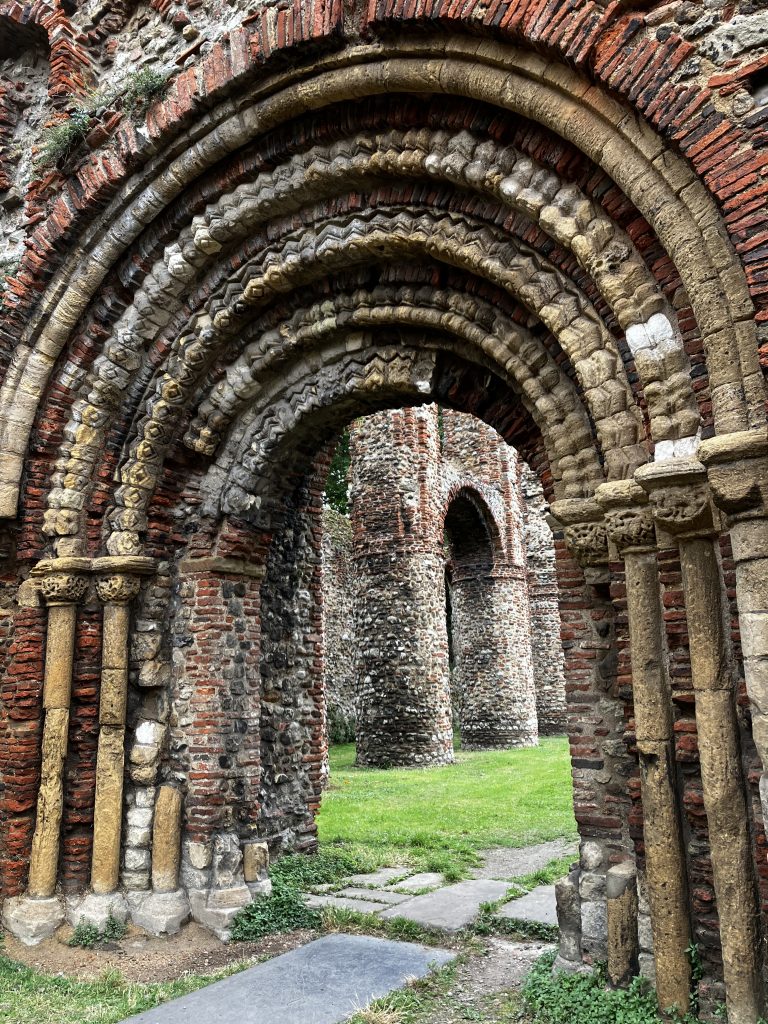
“Colchester has seen better days,” said Scott as we picked our way through the shopping mall in the centre of town.
I nodded in reply, keeping a tight grip on my iPhone. There were quite a few dodgy-looking people hanging around.
However, once we got the stuff from the chemist that Scott needed to fight his chest infection, we were out of there and on to the HISTORY!
The Priory at Colchester is a fabulous example of 1100’s Norman architecture.
A surprising amount of the original building is still standing. Normally, there’s just a couple of walls standing, but with this abbey you csn get a feal feel for the layout of the place. These sturdy circular columns were certainly built to last!
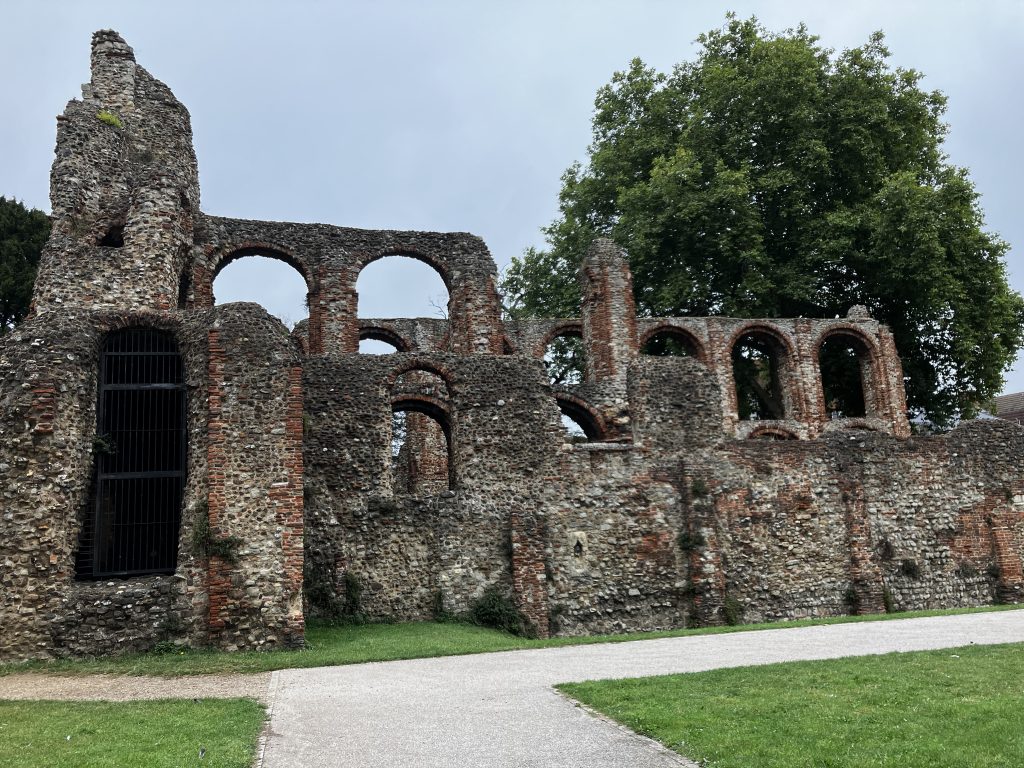
The information board says, “The priory of St Julian and St Botolph was founded in 1103 by a community of priests who had previously served an important church on this site. The dedication to St Botolph, an East Anglian abbot who died in 680, indicates a Saxon origin for the community.”
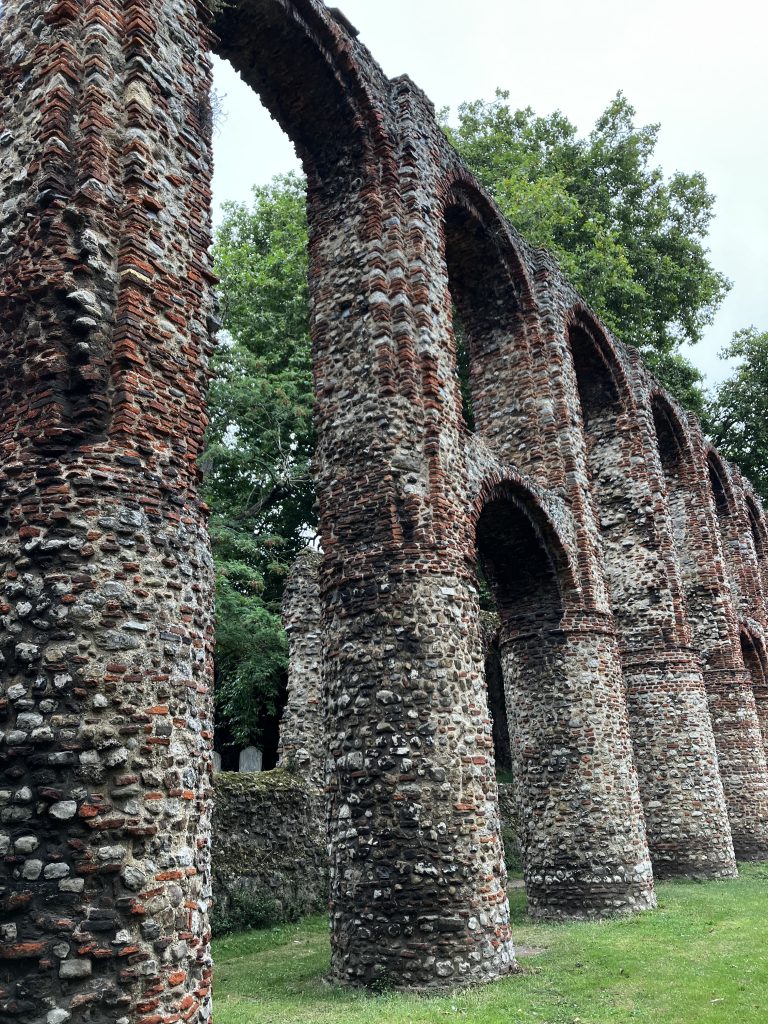
“Influenced by widespread church reforms, the community chose to embrace the full religious life in the 1090s.”
So this was all well and good, but things went a little sour when 500 years later, Henry VIII decided to create the Church of England and grab all of the abbeys and churches for himself and his friends.
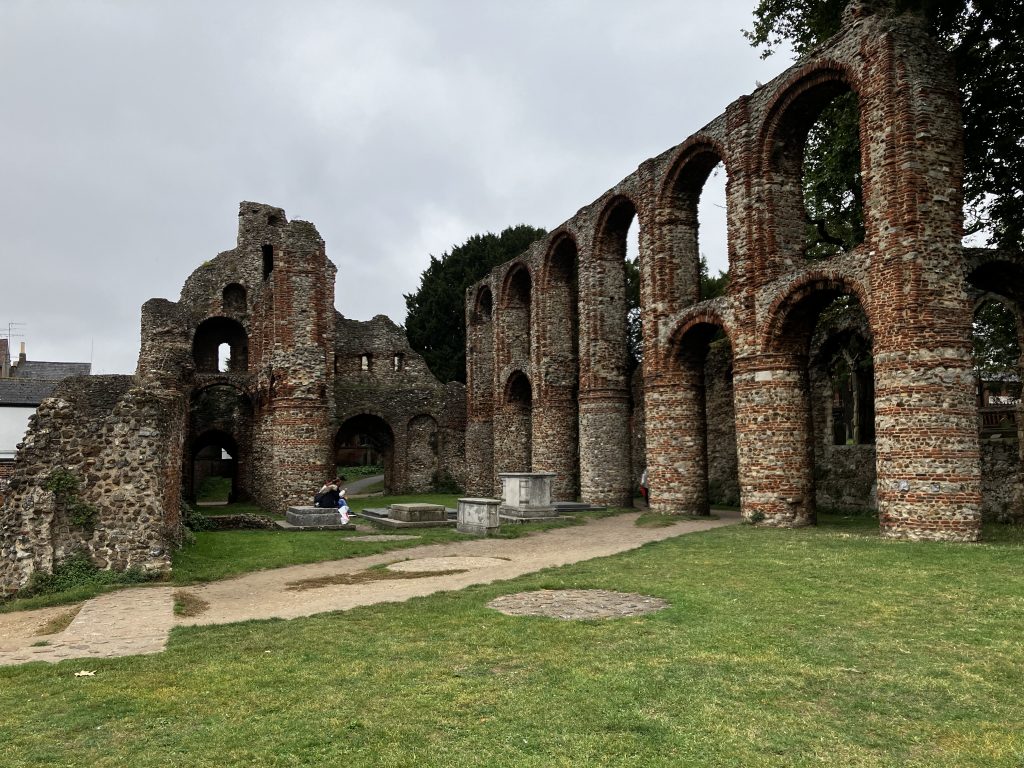
But get this…!
“By the early 1530s, the priory was home to a much reduced community. It was closed on the orders of Henry VIII in 1536 and its assets were granted to Sir Thomas Audley, the king’s Lord Chancellor who died in 1544.
Sir Thomas Audley!!!!
We were at Audley End only two days ago. I love it when the patchwork starts coming together.
This ruin was so beautiful.
But a castle was awaiting us.
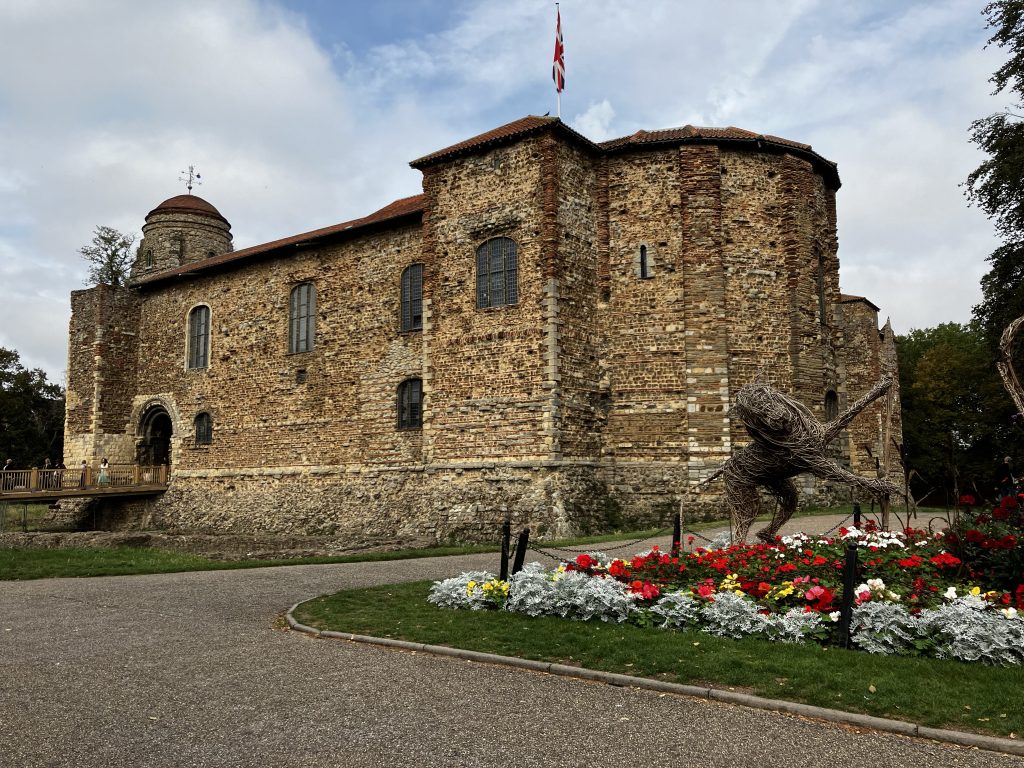
Colchester is the oldest city in the UK. The Romans established it as their capital city here. It was completely torn down and burned to a crisp when Boudicca rebelled against the Romans. Even today, if you dig far enough, you’ll find a thick layer of black that marks where Boudicca and her troops taught the Romans a lesson. It’s called “The Boudicca Destruction Layer.” I think London has one too.
We’ll return to those days in a second.
Colchester Castle is the largest Norman keep in Europe. It’s built to the same plan as the White Tower in the Tower of London, but it’s 50% bigger. No-one knows how tall the castle was. 2, 3 or 4 floors. Drawings differ.
Anyway, in 1074 it was built. It was used extensively until the late 1200’s until the crown sold it in 1670.
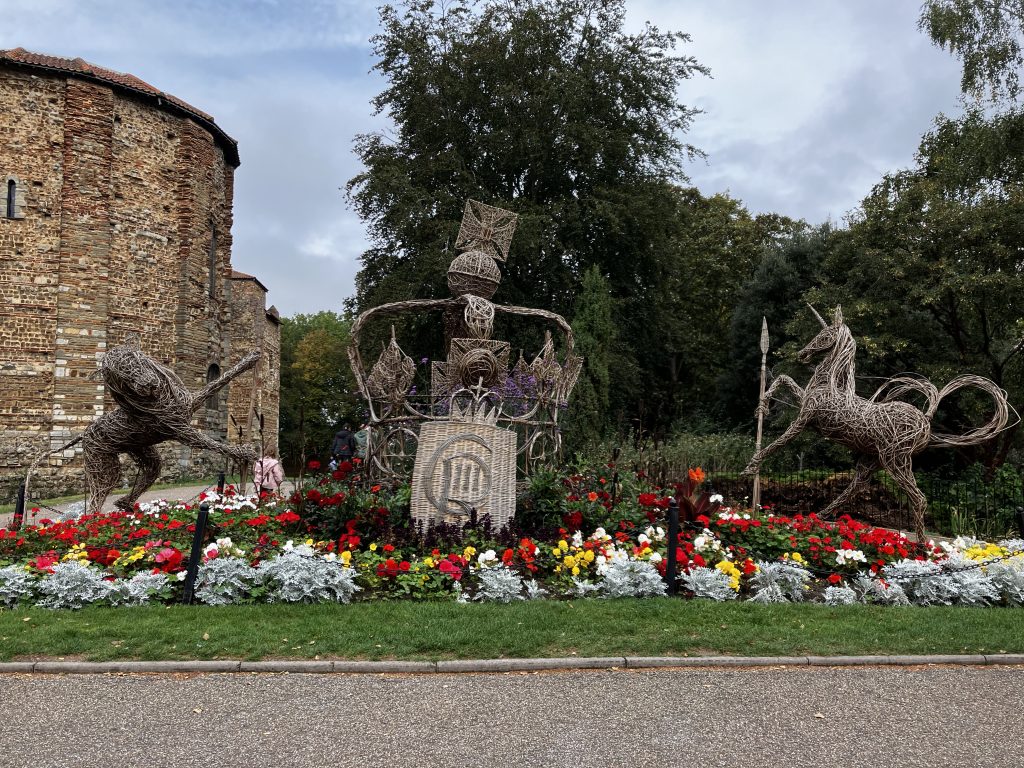
But first – they had this excellent sculpture in the gardens to celebrate the recent coronation. It looked really good. It’s made from woven willow branches.
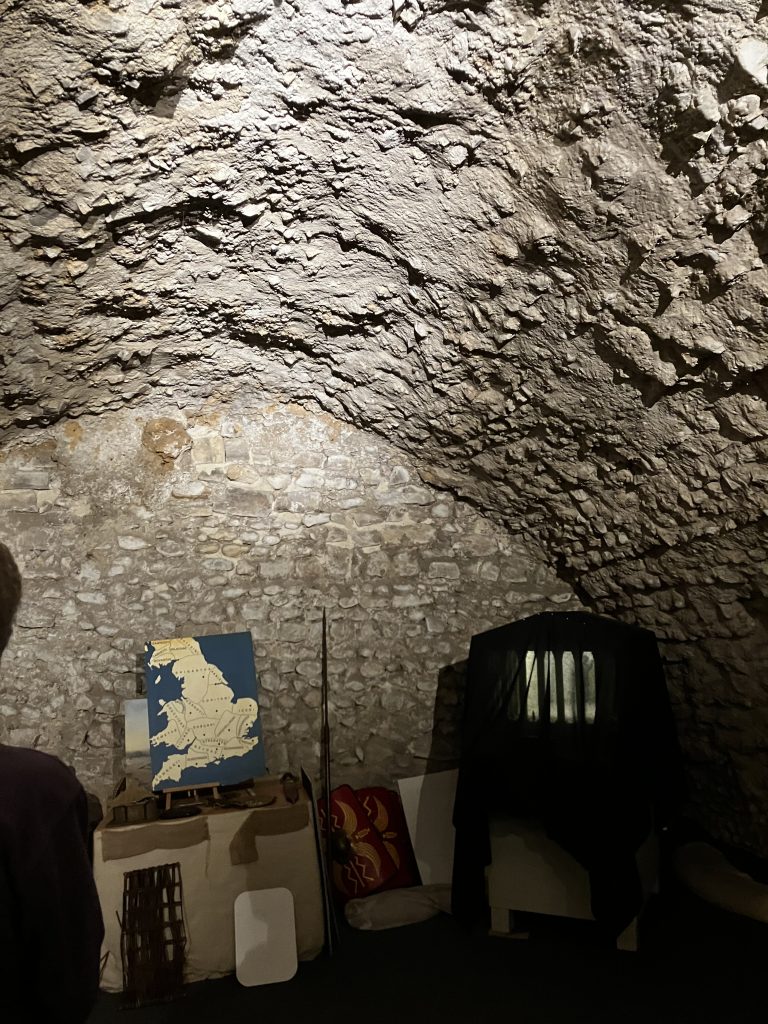
Fortunate Frogdancer and Scott arrived at the castle just in time to jump onto a guided tour. I really like these… you often hear bits and pieces that you wouldn’t otherwise get to know.
The tour began under the castle. Down in the foundations, which were originally the foundations of a Roman Temple for Claudius.
When Emperor Claudius was alive, he brought troops over to England to expand the Roman Empire. There had been a bit of trade going on between the Romans and Saxons, but when he turned up for 3 days (after the fighting had finished) with a few thousand troops and 18 elephants, then Colchester and it’s surroundings became part of the Roman Empire.
When Claudius died a few years later, he became a god (of course) and so a huge temple was built at Colchester.
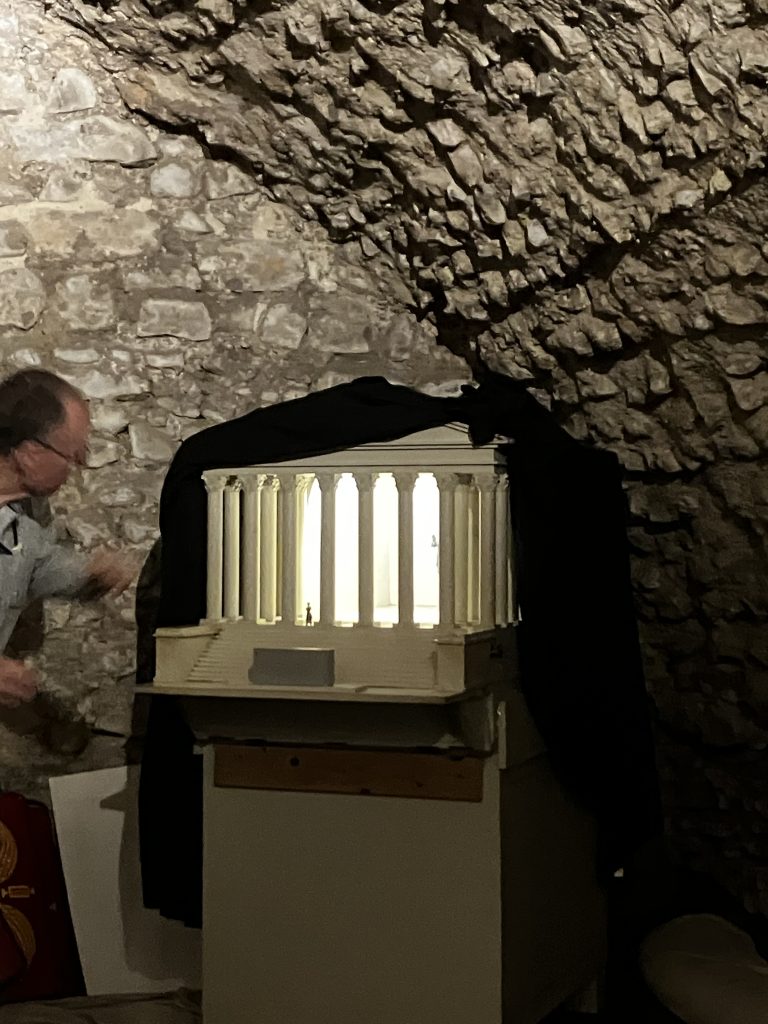
Here’s the guide, down in the vaults, showing us a model. It’s to scale… see the tiny human figure on the front steps?
Anyway, the temple was only up and running for 3 years when Boudicca swung into town in 860 or 861 and everything was toppled and burned to the ground, including the temple.
Not to be deterred, the temple was rebuilt, along with the rest of the town, and was in use for another 3 or 4 centuries, until the Romans packed up and left in 410. After that, it quietly sat there being gradually plundered for building supplies for people’s houses probably, until William the Conqueror came along and needed a castle built pronto.
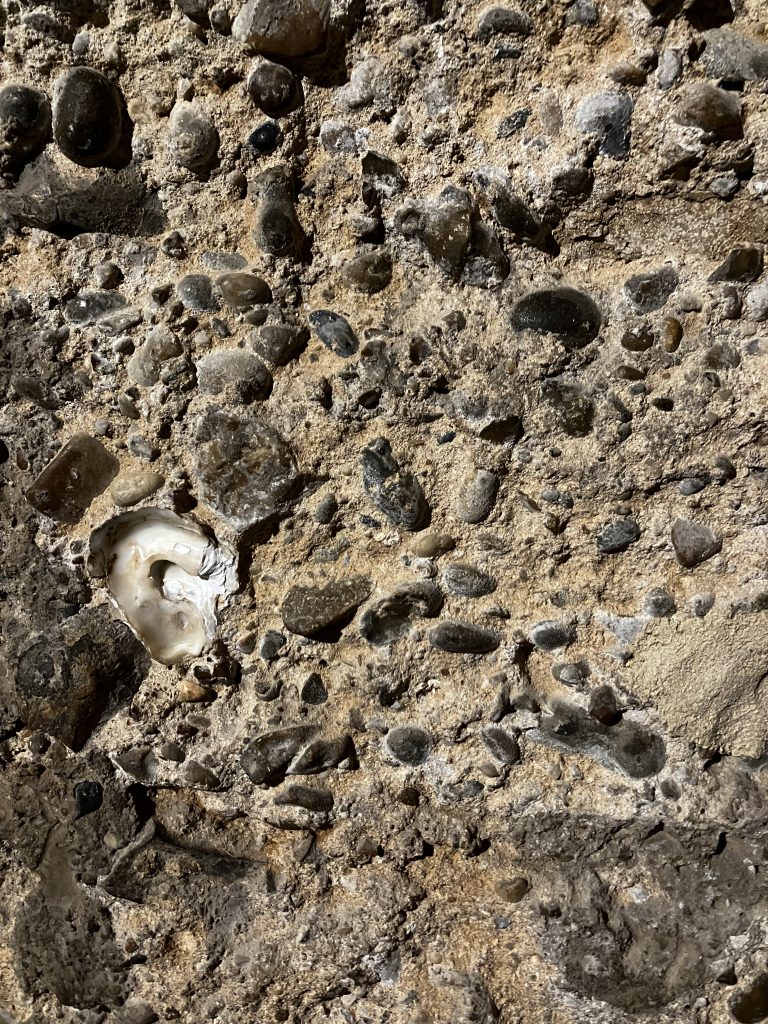
The walls of the vaults all look like this. They are made of mudstone brought out from the river, with the lower levels being made of sand to stabilise the whole building. The white bit to the left is an oyster shell. The guide said that a worker must have thrown it aside after eating the oyster for lunch.
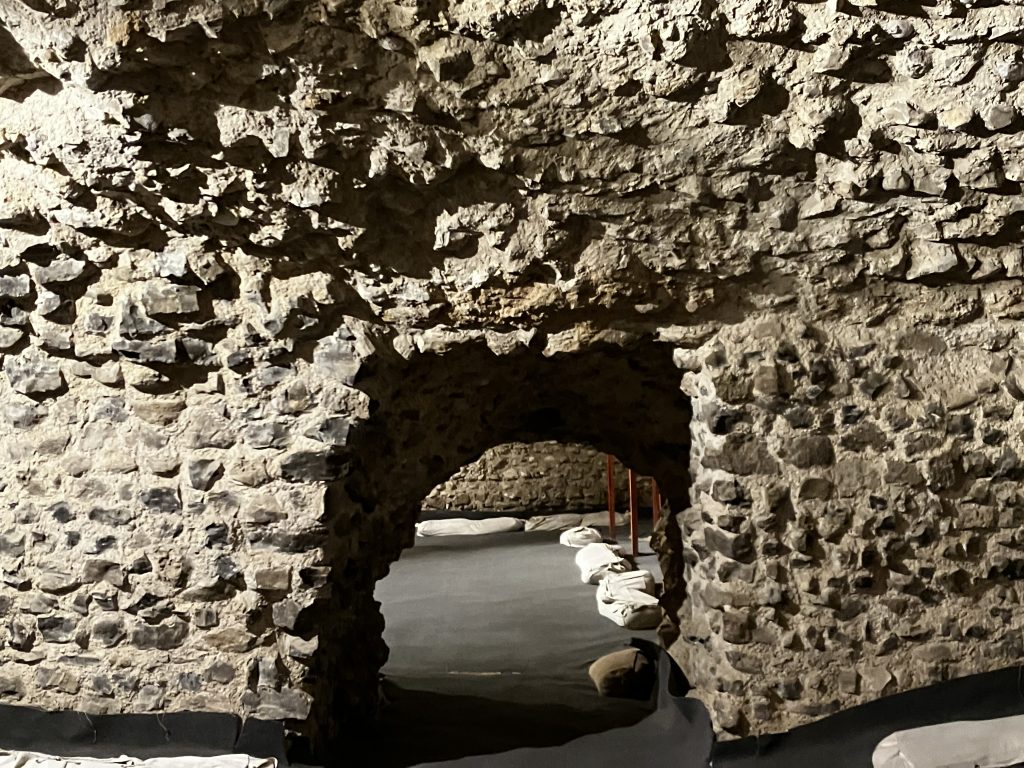
The gaps between rooms were very small.
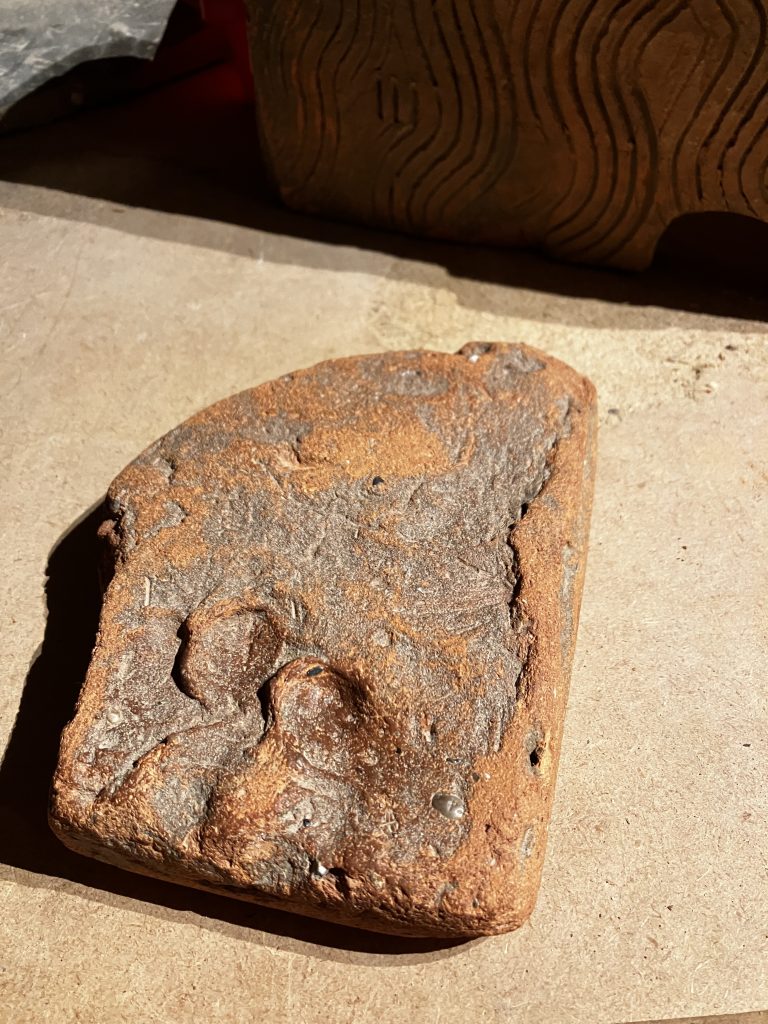
Look at this! A Roman tile, complete with finger marks from the man who made it. We passed this around the group. We see so many of these tiles as we go around and look at the old churches.
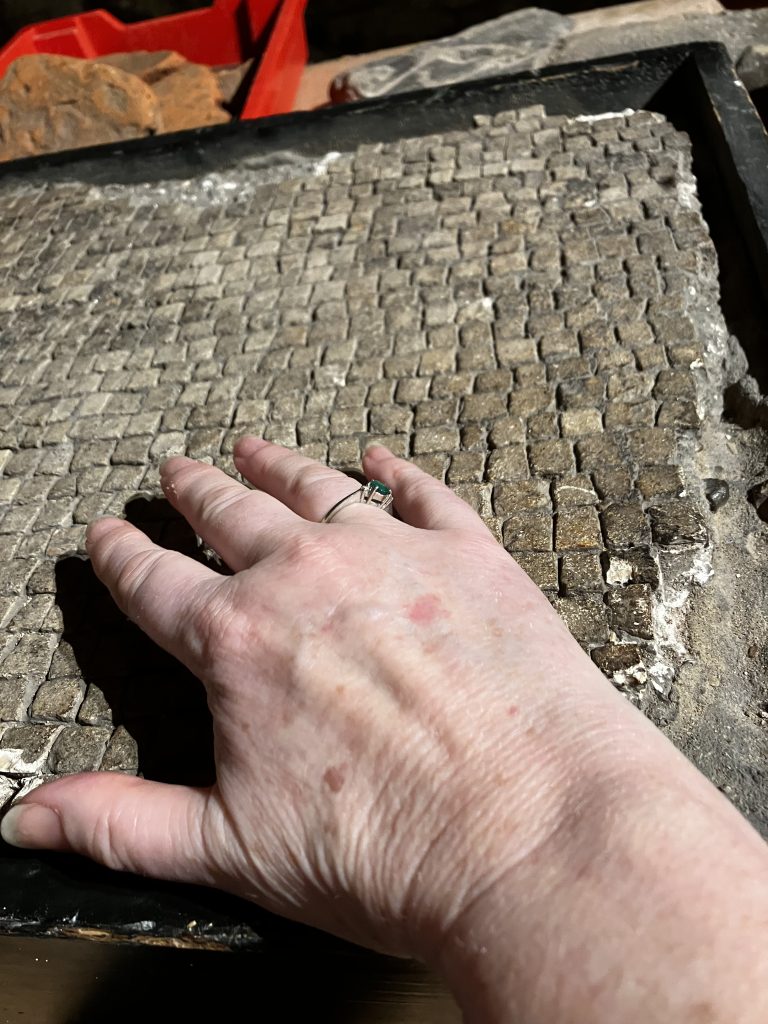
And this is part of a Roman mosaic.
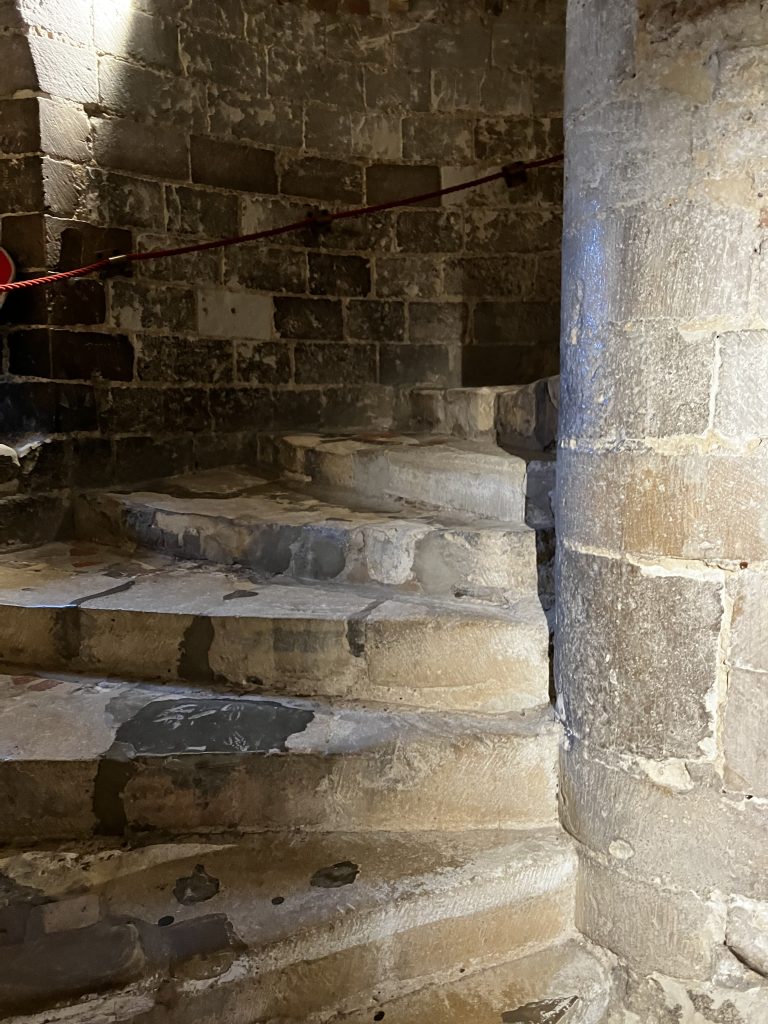
Then it was up to the Great Stairs. These are 4.8 metres in diameter and are the largest stairs in a Norman castle in England. Notice how the spiral turns to the right? This castle was built for defence.
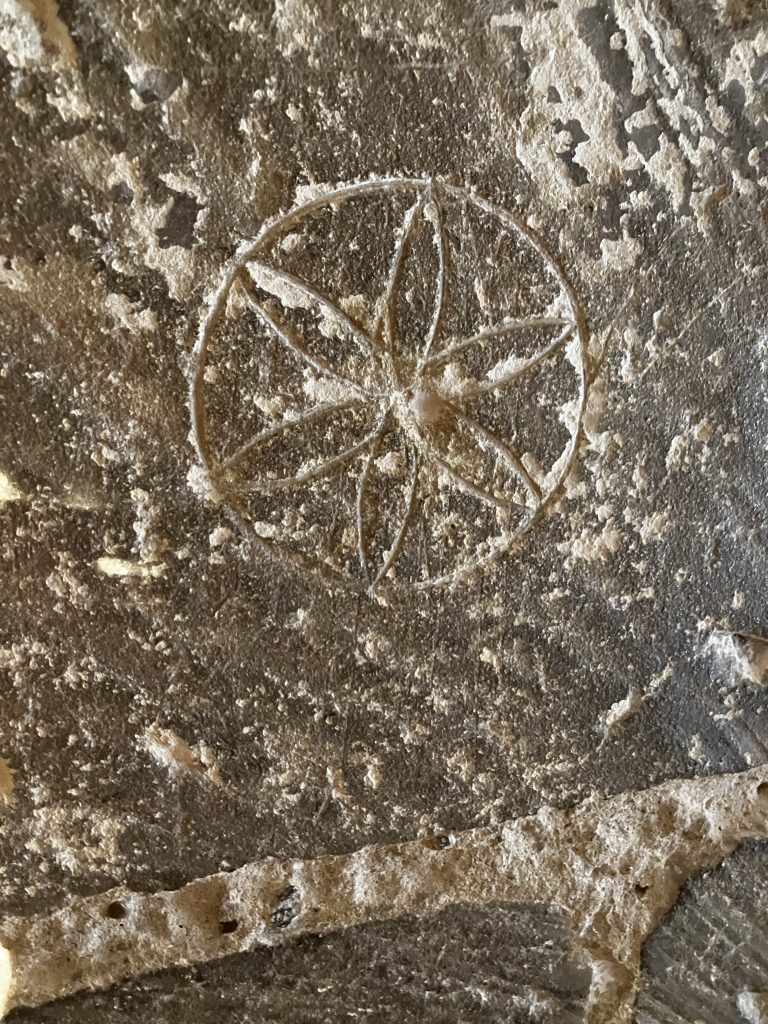
As we were standing at the bottom of the stairs, we could see some graffiti that had been carved into the walls over the years. The guide pointed this one out and said that it was a sign to ward off witches.
There was a witch hunter who lived at the castle for a while. He died when he was 27, but before that he killed over 200 “witches.”
I bet you a million dollars that if I’d been alive then, I would’ve been in trouble. Me with my 3 “familiars”, my herb growing and single ways…
Unless my 4 sturdy sons saved me. But then again, I would have died in childbirth trying to deliver Tom31, so I would have been pretty much screwed either way.
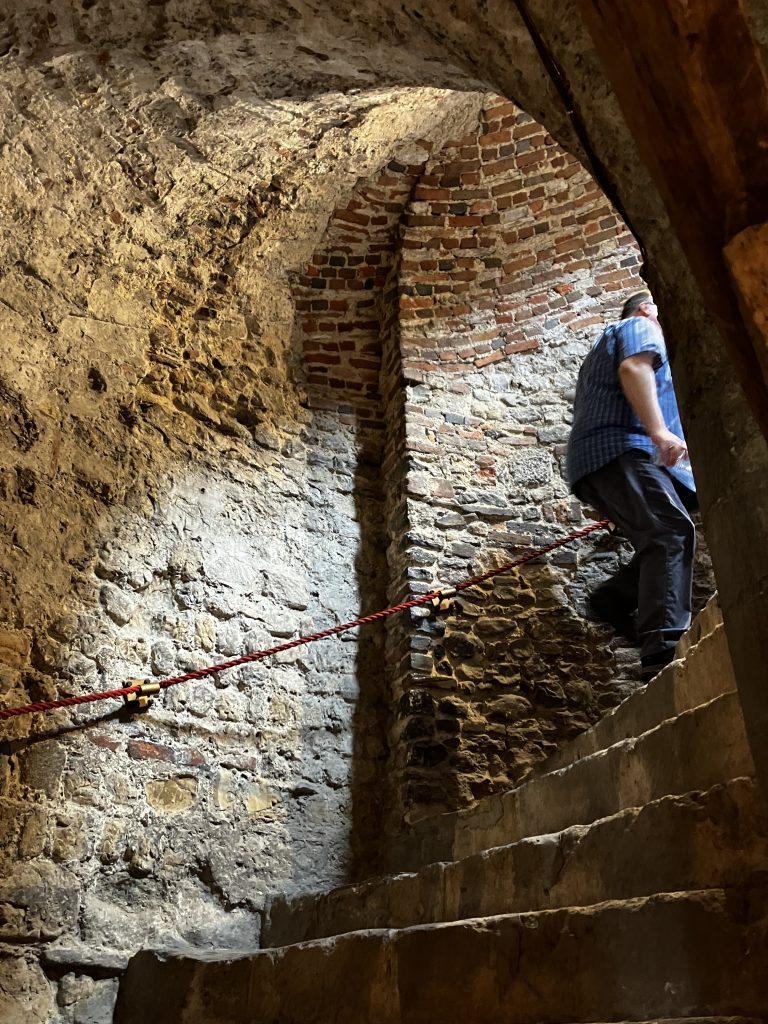
Up we went, and onto the roof.
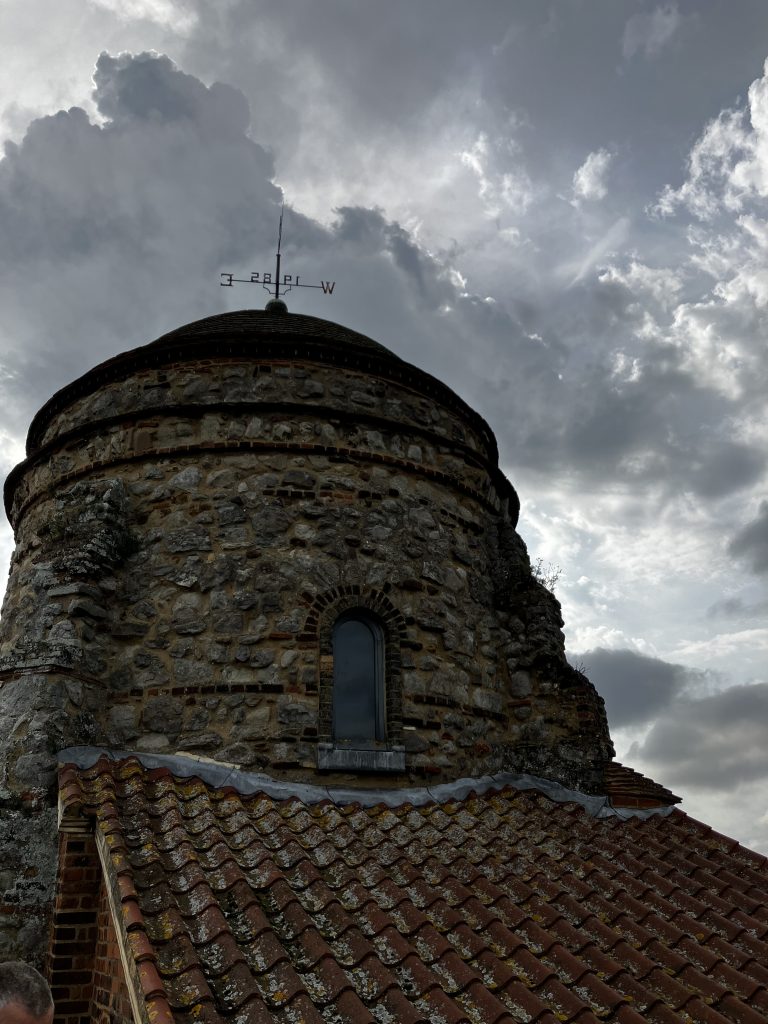
It was good to be out in the open air, looking at the view.
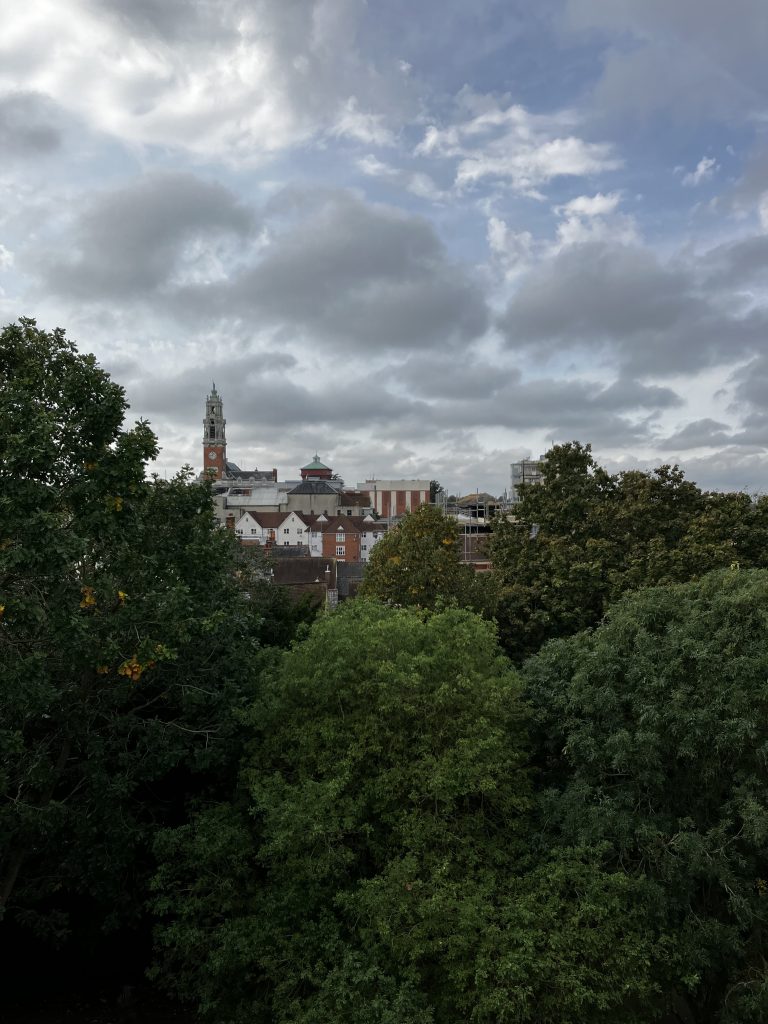
As we emerged out of a doorway back to the upper floor of the castle, we found ourselves in the middle of a group of primary school kids who were there on an excursion.
“What’s behind that door?” demanded a blond, bullet-headed boy with piercing blue eyes.
“I can’t tell you,” I said. “It’s for grownups.”
“Awwww,” he said.
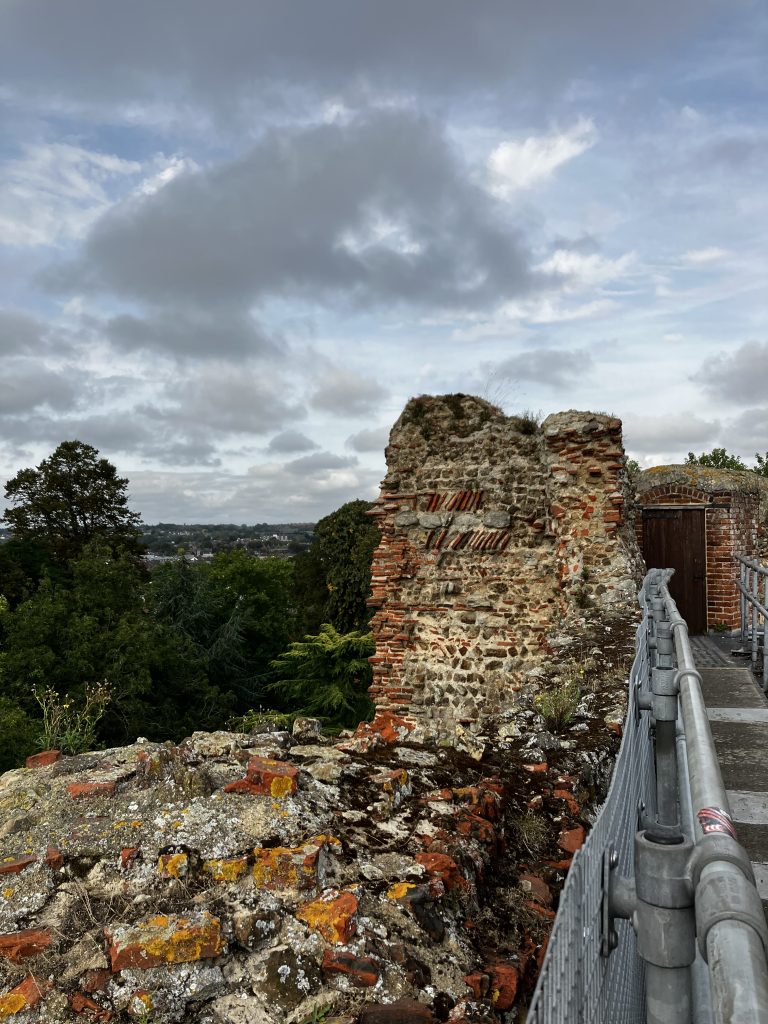
Later, I bumped into him again.
“No really, how did you get behind that door?” he demanded.
“I’m sorry. They only let Australians see behind the door. I’m Australian,”.
His face darkened with indignation. “But I’m from Colchester!”
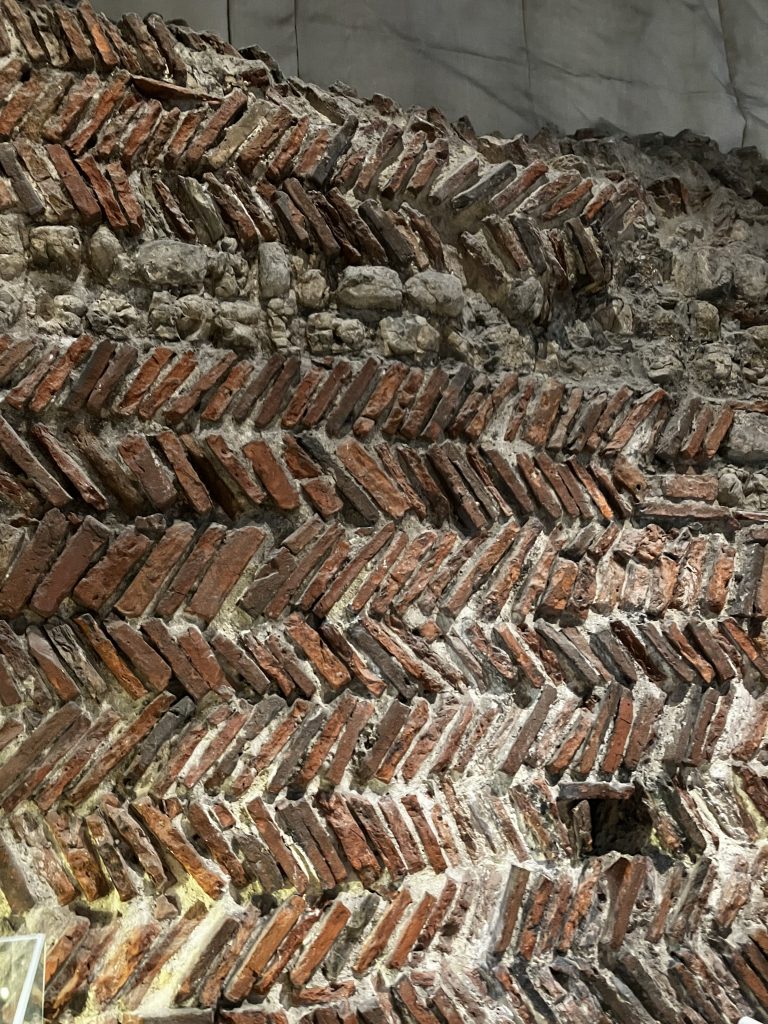
Look! Roman tiles being recycled in the castle!
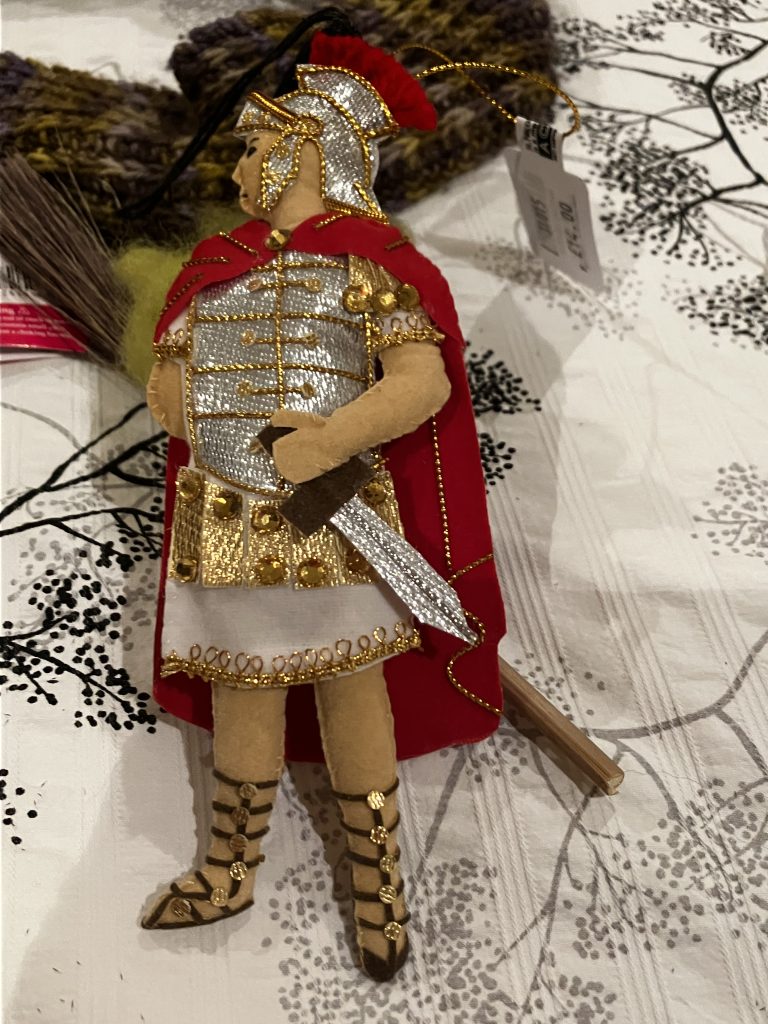
A Roman soldier for the Christmas tree.
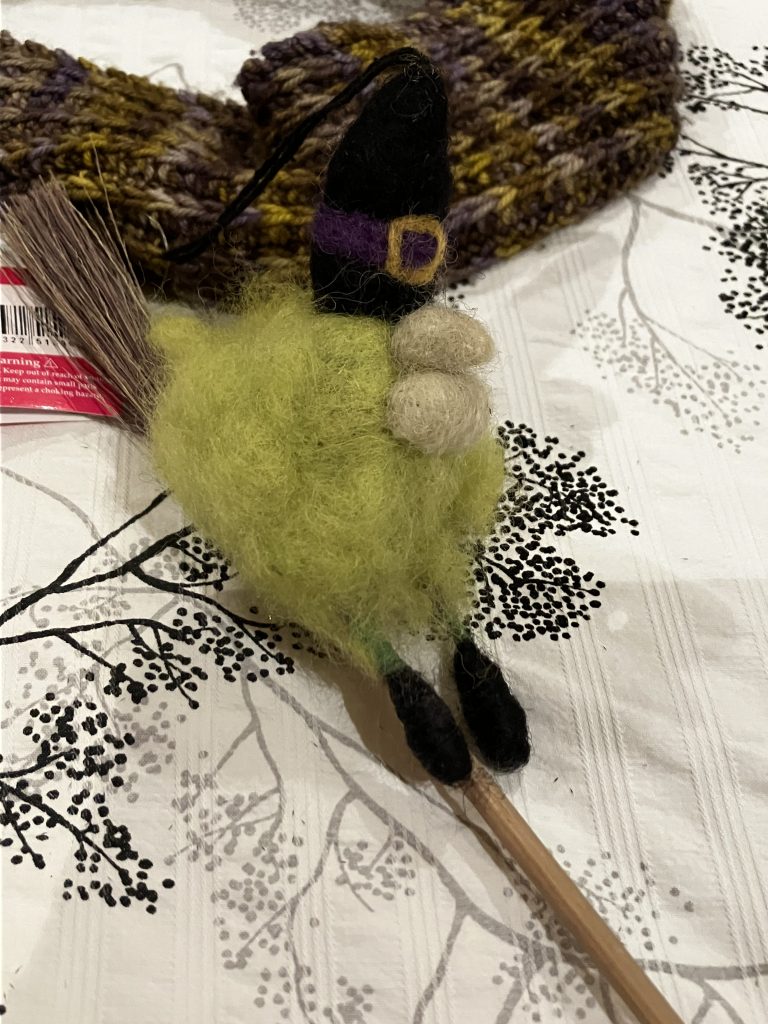
And a witch.
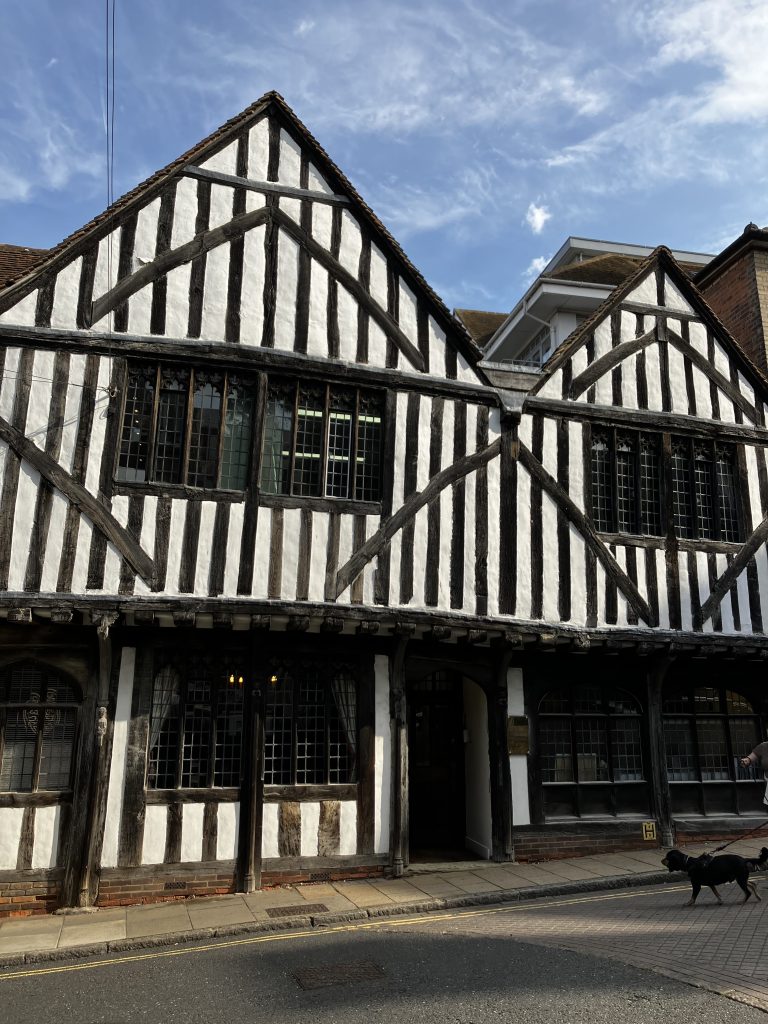
We wandered around town for a while after we left the castle. There were a few pretty buildings around.
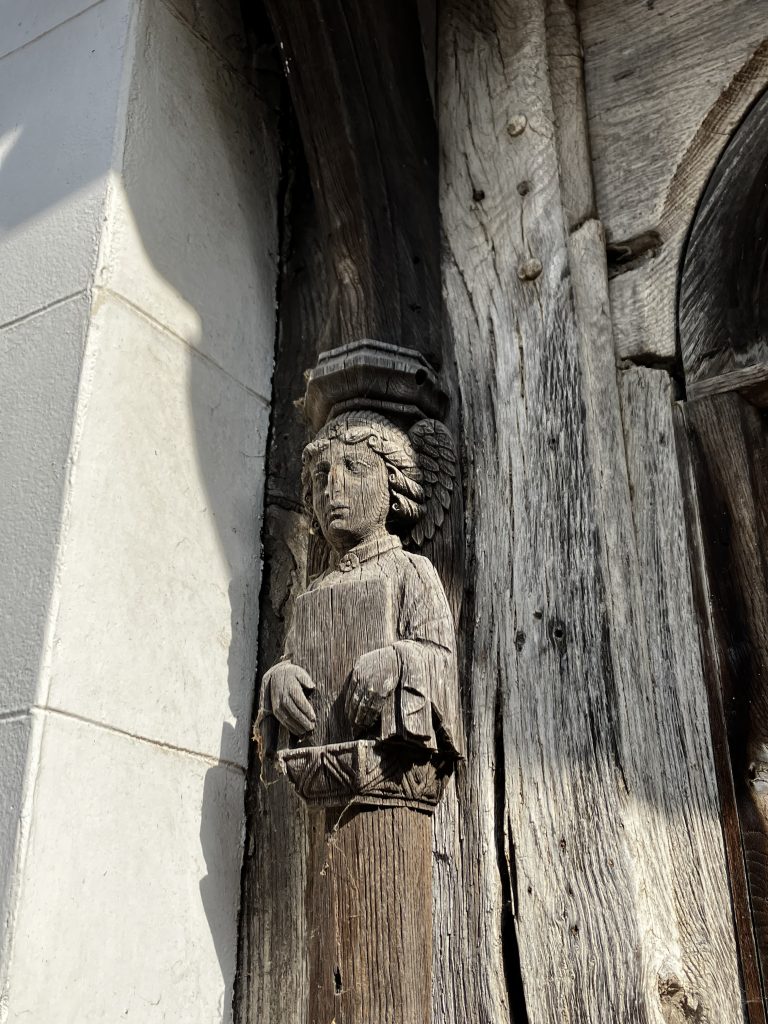
You can just about see this little guy on the photo above. By the way, I patted that dog.
It’s the last week of my holiday and I’m missing the little woofs. Oh! And the boys, of course.
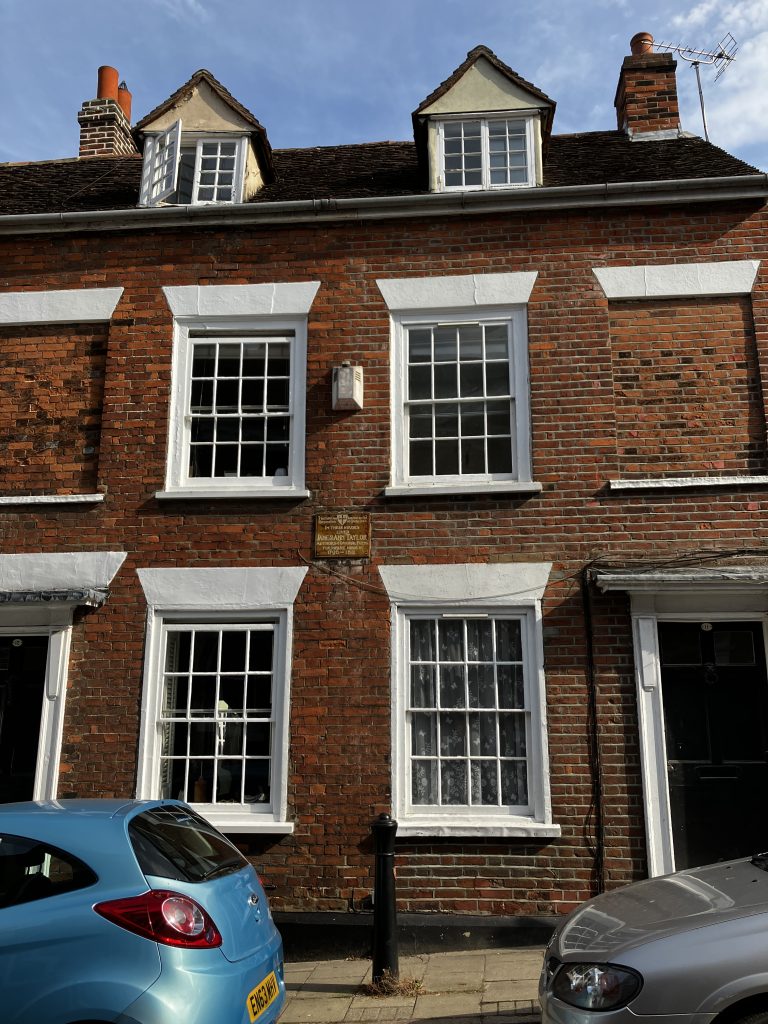
This house doesn’t look like anything special, but some extremely influential people once lived here.
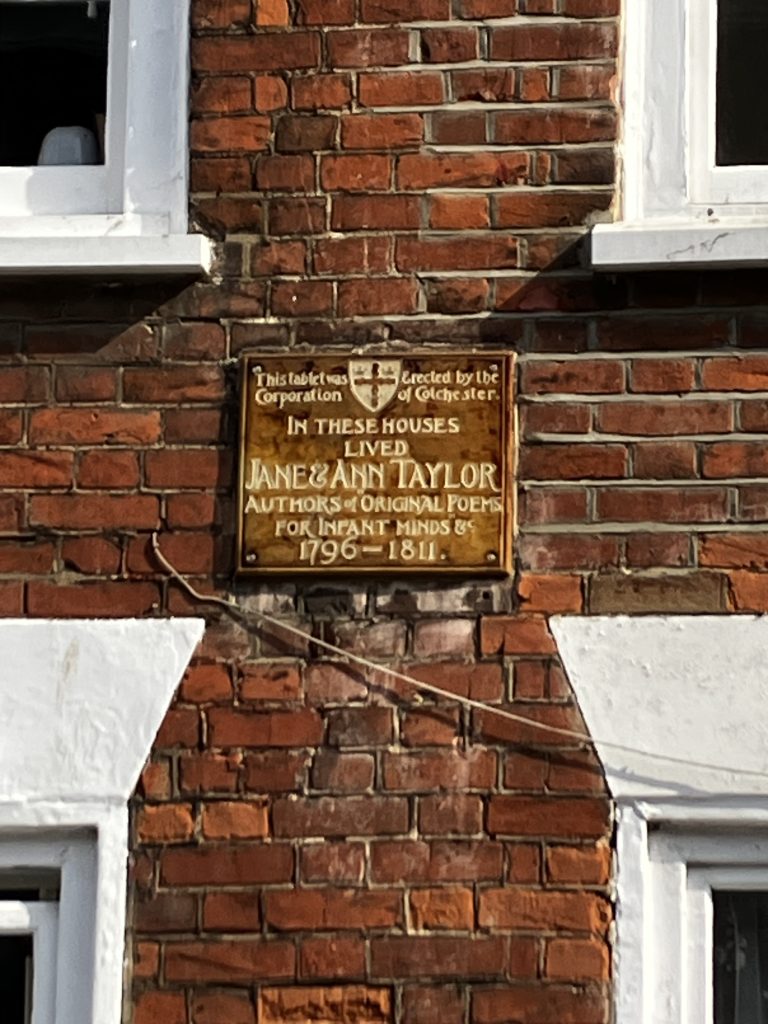
These women wrote “Twinkle Twinkle Little Star,” among other nursery rhymes.
After a sumptuous lunch of McDonalds, sitting on some benches near he bus stop, we went back to the car to track down something called “A House for Essex.”
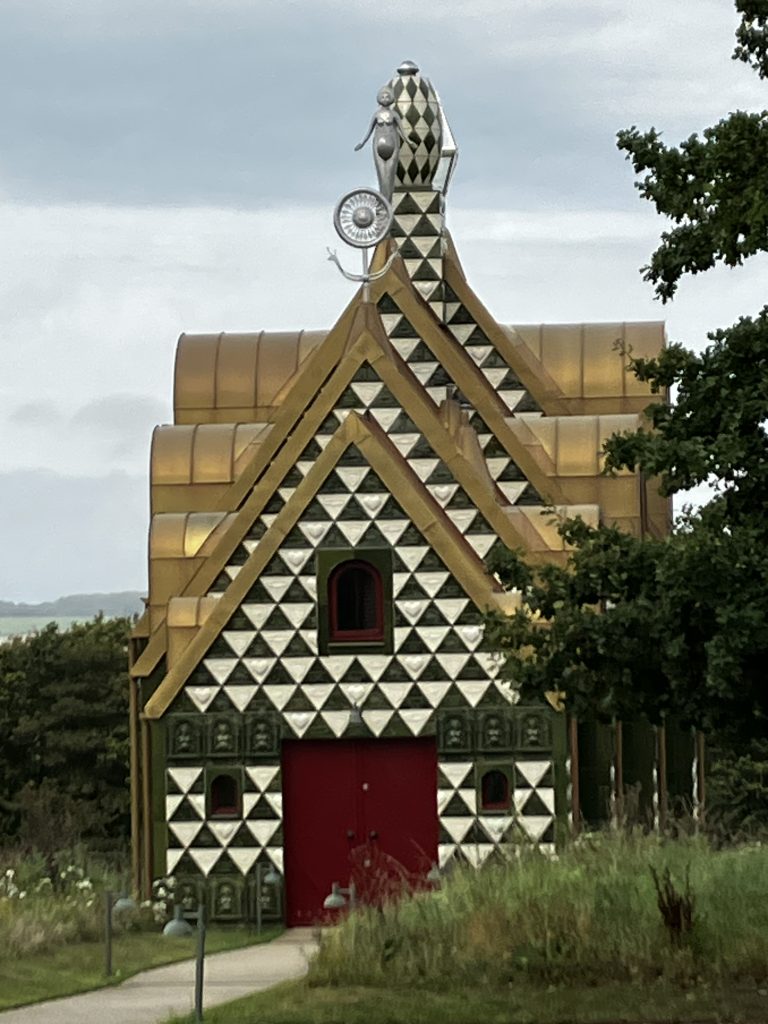
There’s a guy called Grayson Perry who’s way famous in the UK. He’ an artist, documentary maker, cross-dress and ceramics maker who designed this holiday home in the middle of nowhere.
Here’s how Wikipedia describes the house:
“The house encapsulates the story of Julie May Cope, a fictional Essex woman,[47] “born in a flood-struck Canvey Island in 1953 and mown down last year by a curry delivery driver in Colchester”.[48] Writing in The Daily Telegraph, Ellis Woodman said, “Sporting a livery of green and white ceramic tiles, telephone-box red joinery and a gold roof, it is not easy to miss. … Decoration is everywhere: from the external tiles embossed with motifs referencing Julie’s rock-chick youth to extravagant tapestries recording her life’s full narrative. Perry has contributed ceramic sculptures, modelled on Irish Sheelanagigs, which celebrate her as a kind of latter-day earth mother while the delivery driver’s moped has even been repurposed as a chandelier suspended above the double-height living room.”[48]“
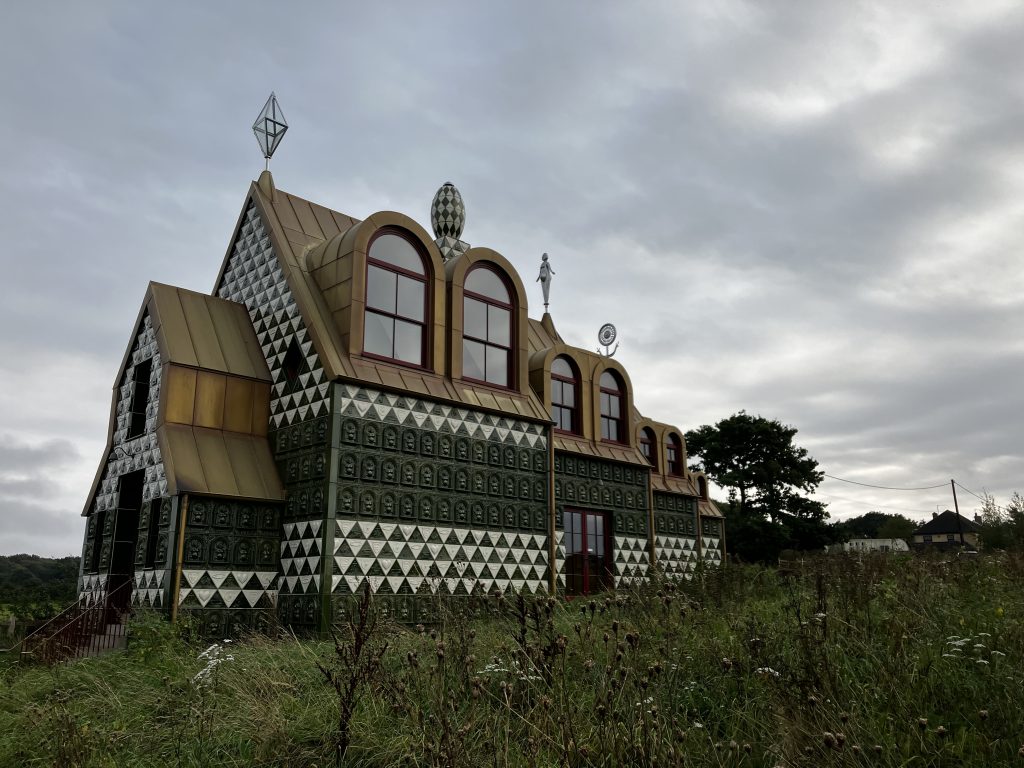
It’s certainly eye-catching.
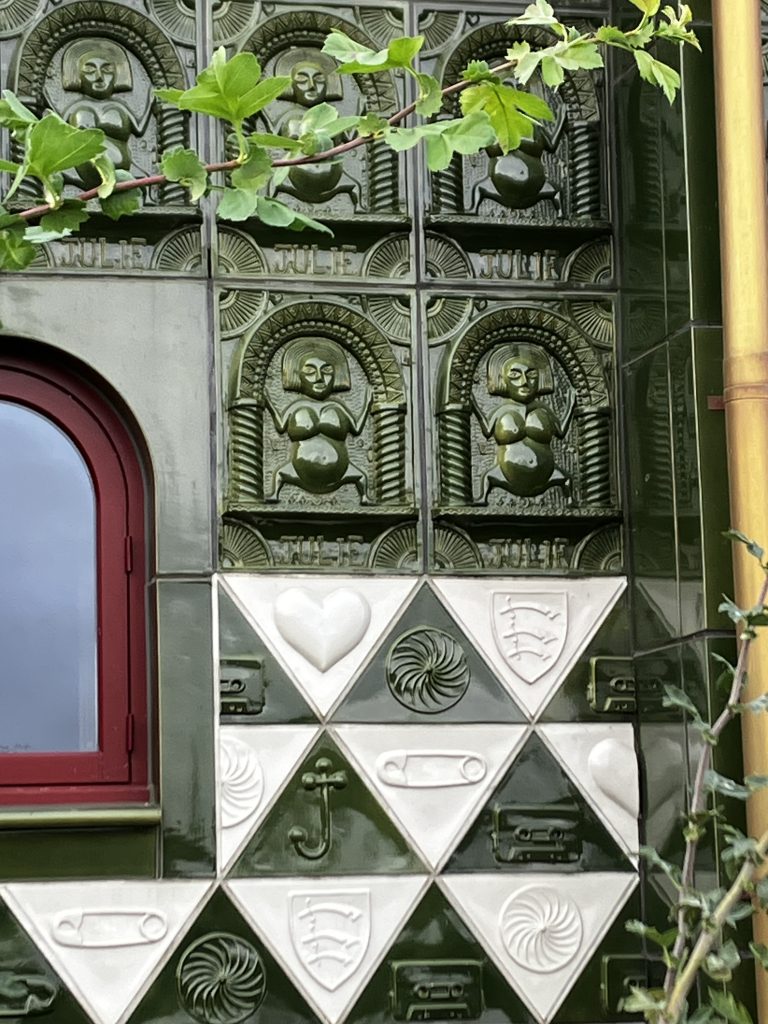
Scott was more enamoured with it than I was.
The nappy pins on the tiles were a whimsical touch, though.
You can rent the house for a little getaway, but you’d have to be prepared to have tourists peering through the windows.
Then we were off to Harwich, pronounced “Horritch” for some inexplicable English reason. Scott says it’s so they can spot the outsiders.
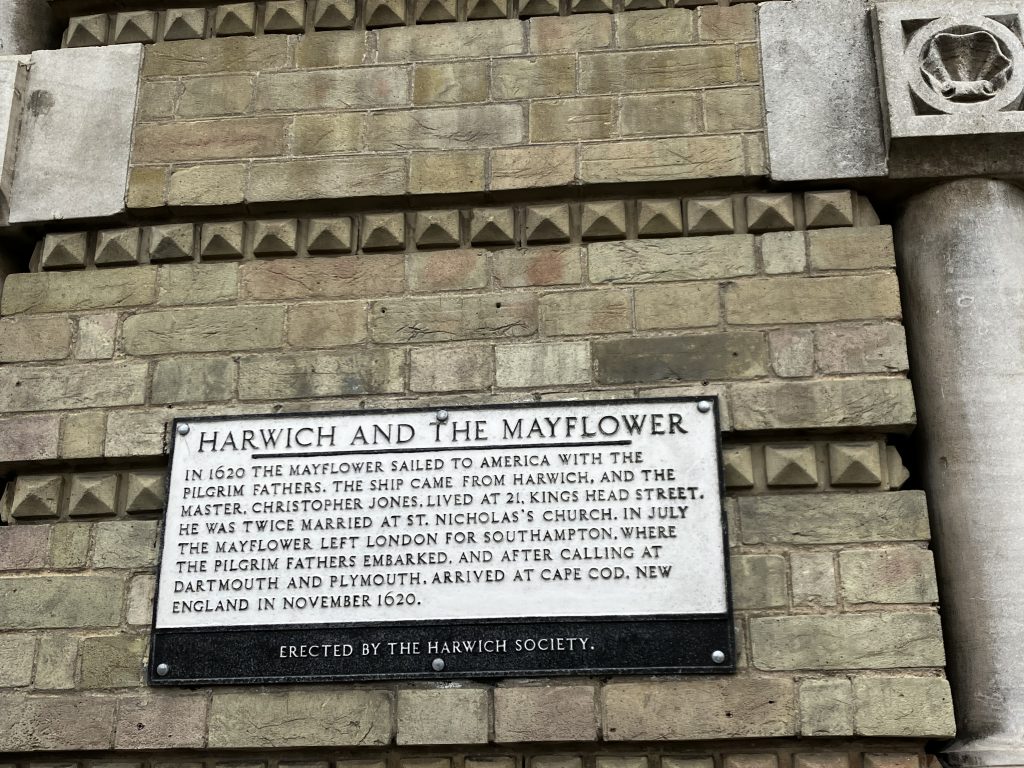
Harwich is supposed to be where the Mayflower set sail. Personally, I think that any boat full of religious extremists is bad news, but Harwich is milking this for all it’s worth, even though it’s not absolutely certain that this was the port.
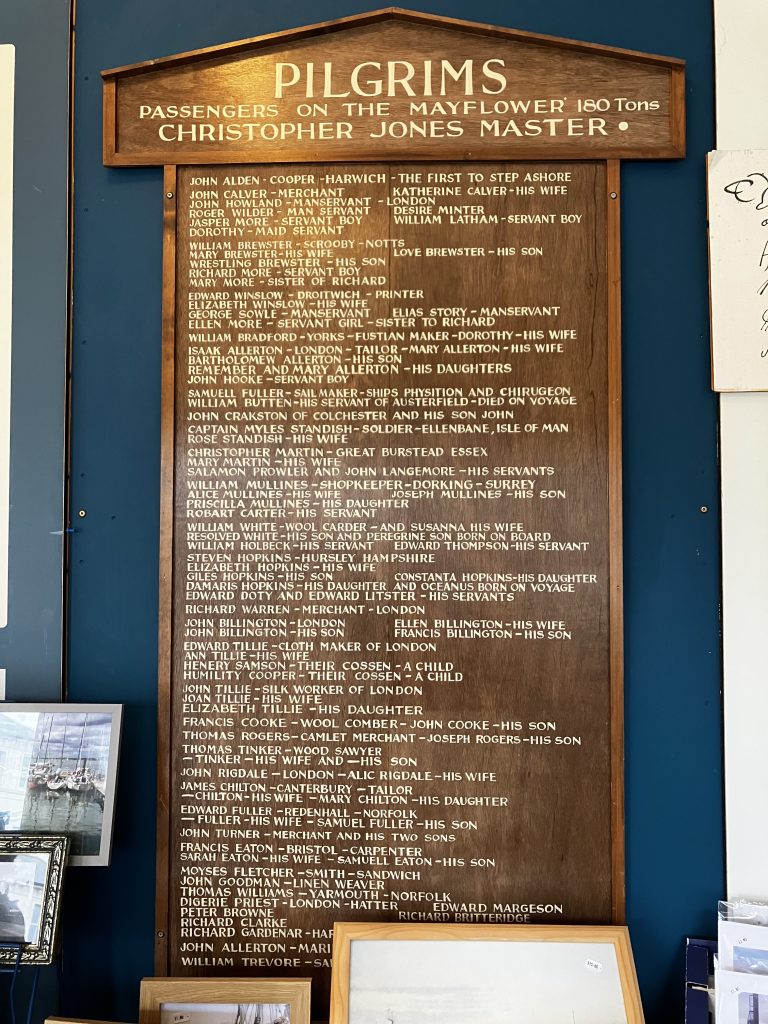
It’s worth looking at the board to see some of the names. A few of these people have names that would take an awful lot to live up to.
And the baby born at sea on the way to America?
Oceanus.
That poor kid.
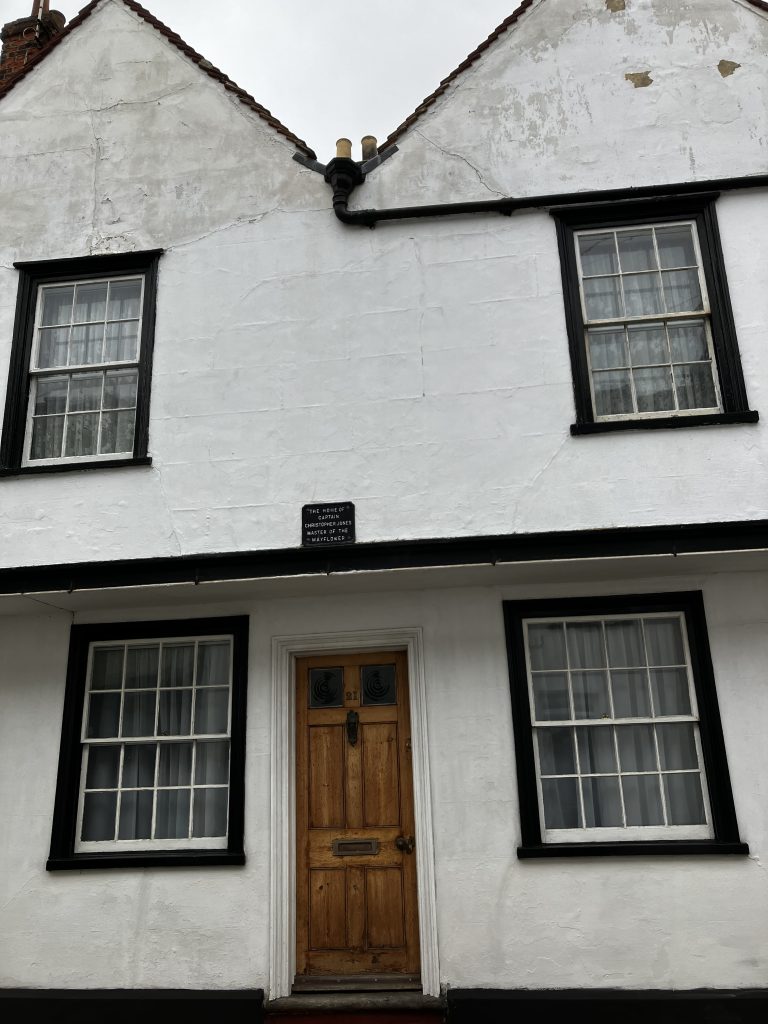
One thing Harwich IS sure about is that the captain of the Mayflower was a home-town boy. Here’s his house.
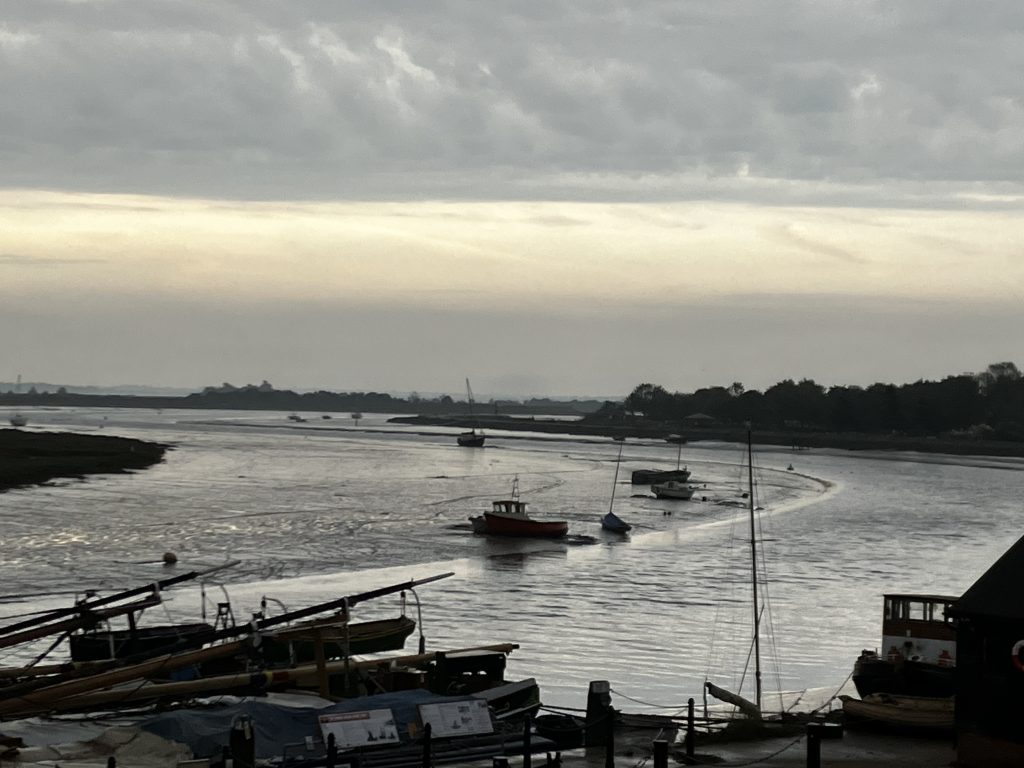
The weather had turned and it was starting to rain.
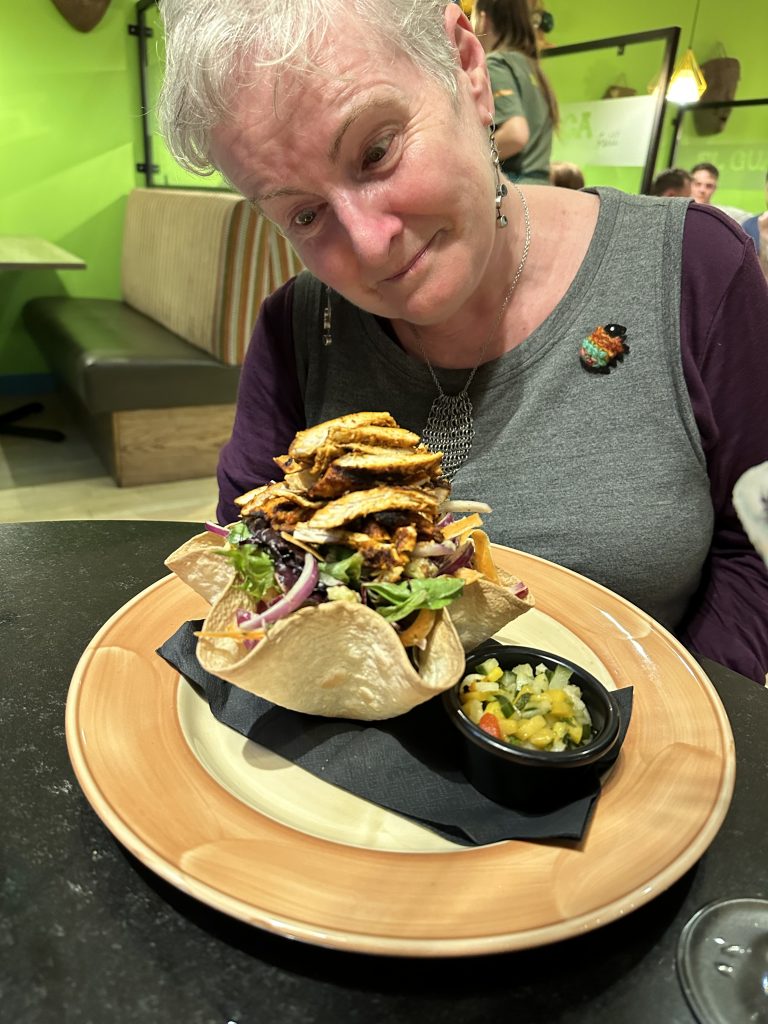
That night we went to a Mexican restaurant, where I ordered a margarita and what I thought would be a light meal of a salad.
it was bigger than my head.
Ah well. At least I went to bed with a full stomach.
I was wondering if you were getting a bit homesick. I have been enjoying both your terrific photos and the excellent history lessons!
I love my history. 🙂
Grayson Perry’s tv shows on ABC iview were fascinating. His wife, Philippa Perry is an interesting person too.
Loving your trip diary! Planning my own UK jaunt for 2024 but am going on a completely different route (walks, beaches, books and food-related rather than history).